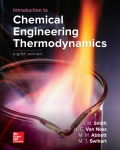
Interpretation:
The temperature of steam at the nozzle entrance under the given conditions needs to be calculated
Concept Introduction:
- The energy balance equation that relates the inlet and outlet enthalpies and velocities is given based on the first law of
thermodynamics as:
- For an adiabatic process, there is no loss or gain of heat i.e. q = 0
Temperature at the nozzle inlet
Given Information:
Outlet Temperature of air T2=
Inlet velocity, u1 = negligible = 0 m/s
Outlet velocity, u2 = 580 m/s
Explanation:
Step 1:
Calculate the change in enthalpy
Based on equation (1) we have:
Step 2:
Calculate the inlet temperature, T1
For an ideal gas the change in enthalpy is related to the change in temperature through the specific heat Cp;
Thus, the temperature at the nozzle inlet
Want to see the full answer?
Check out a sample textbook solution
Chapter 7 Solutions
EBK INTRODUCTION TO CHEMICAL ENGINEERIN
- Homework 8 View Policies Show Attempt History Current Attempt in Progress Question 3 of 5 Entering Steam > > Check table lookups for correct values. Check significant figures. Check unit conversions. Calculate the required flow rate of the entering steam in m³/min. 0.00132 m³/min eTextbook and Media Hint 0/1 Assistance Used Determine the specific enthalpy change of each stream first. Then use the known flow rate of the methanol to calculate the steam flow rate. Save for Later Heat Transferred × Check units and significant figures. Calculate the rate of heat transfer from the water to the methanol (kW). i 44.5 kW Hint Don't forget to convert minutes to seconds. Save for Later Attempts: 3 of 5 used Submit Answer Assistance Used Attempts: 2 of 5 used Submit Answerarrow_forward← Homework 8 View Policies Show Attempt History Current Attempt in Progress A liquid mixture of benzene and toluene containing 52.0 wt% benzene at 100.0 °C and pressure Po atm is fed at a rate of 32.5 m³/h into a heated flash tank maintained at a pressure Ptank Material Balances Correct. 0.67/1 === Attempts: 1 of 5 used Calculate Ptank (atm), the mole fraction of benzene in the vapor, and the molar flow rates of the liquid and vapor products. Ptank .544 atm Ybz .657 mol benzene/mol vapor product nvapor 55.8 mol/s nliquid 37.6 mol/s Hint GO Tutorial Energy Balance Check heat capacities. Calculate the required heat input rate in kilowatts. i 0.447 kW Hint GO Tutorial Save for Later Assistance Used Attempts: 2 of 5 used Assistance Used Attempts: 1 of 5 used Submit Answerarrow_forwardView Policies Show Attempt History Current Attempt in Progress Homework 8 A stream of pure cyclopentane vapor flowing at a rate of 1650 L/s at 190.0°C and 1 atm enters a cooler in which 50.0% of the feed is condensed at constant pressure. Question 4 of 5 Correct What is the temperature at the condenser outlet? 49.3 °℃ eTextbook and Media Hint Enthalpy Table Your Answer Correct Answer (Used) 0.67/1 E Attempts: 1 of 5 used Prepare and fill in an inlet-outlet enthalpy table. Use a reference state of liquid cyclopentane at the boiling point. In T = 190.0°C Out T=49.3°C Substance n (mol/s) Ĥ (kJ/mol) n (mol/s) Ĥ (kJ/mol) C5H10(1) 0.0 21.708 0.0 C5H10(V) 43.416 43.687 21.708 27.30 Heat Check significant figures and sign. Calculate the required cooling rate (a positive number). ! kW Hint Save for Later Attempts: 3 of 5 used Submit Answerarrow_forward
- View Policies Show Attempt History Current Attempt in Progress A liquid mixture of benzene and toluene containing 52.0 wt% benzene at 100.0 °C and pressure Po atm is fed at a rate of 32.5 m³/h into a heated flash tank maintained at a pressure Ptank Your answer is partially correct. 1.312 atm Assistance Used 0.58/1 Calculate Ptank (atm), the mole fraction of benzene in the vapor, and the molar flow rates of the liquid and vapor products. Ptank i atm .657 Ybz mol benzene/mol vapor product nvapor 55.8 mol/s nliquid 37.6 mol/s Hint GO Tutorial Save for Later Energy Balance Calculate the required heat input rate in kilowatts. i kW GO Tutorial Save for Later Assistance Used Attempts: 1 of 5 used Submit Answer Assistance Used Attempts: 0 of 5 used Submit Answerarrow_forwardView Policies Show Attempt History Current Attempt in Progress Saturated steam at 342.1°C is used to heat a countercurrently flowing stream of methanol vapor from 70.0°C to 321.7°C in an adiabatic heat exchanger. The flow rate of the methanol is 5530 standard liters per minute, and the steam condenses and leaves the heat exchanger as liquid water at 95.0°C. Physical Property Tables Entering Steam Homework 8 Question 3 of 5 Check unit conversions. Calculate the required flow rate of the entering steam in m³/min. 0.0165 m³/min eTextbook and Media Hint Save for Later Heat Transferred * Check units and significant figures. Calculate the rate of heat transfer from the water to the methanol (kW). i 58.7 kW Hint Save for Later 0/1 EE Attempts: 1 of 5 used Submit Answer Attempts: 1 of 5 used Submit Answerarrow_forwardheat and mass transferarrow_forward
 Introduction to Chemical Engineering Thermodynami...Chemical EngineeringISBN:9781259696527Author:J.M. Smith Termodinamica en ingenieria quimica, Hendrick C Van Ness, Michael Abbott, Mark SwihartPublisher:McGraw-Hill Education
Introduction to Chemical Engineering Thermodynami...Chemical EngineeringISBN:9781259696527Author:J.M. Smith Termodinamica en ingenieria quimica, Hendrick C Van Ness, Michael Abbott, Mark SwihartPublisher:McGraw-Hill Education Elementary Principles of Chemical Processes, Bind...Chemical EngineeringISBN:9781118431221Author:Richard M. Felder, Ronald W. Rousseau, Lisa G. BullardPublisher:WILEY
Elementary Principles of Chemical Processes, Bind...Chemical EngineeringISBN:9781118431221Author:Richard M. Felder, Ronald W. Rousseau, Lisa G. BullardPublisher:WILEY Elements of Chemical Reaction Engineering (5th Ed...Chemical EngineeringISBN:9780133887518Author:H. Scott FoglerPublisher:Prentice Hall
Elements of Chemical Reaction Engineering (5th Ed...Chemical EngineeringISBN:9780133887518Author:H. Scott FoglerPublisher:Prentice Hall
 Industrial Plastics: Theory and ApplicationsChemical EngineeringISBN:9781285061238Author:Lokensgard, ErikPublisher:Delmar Cengage Learning
Industrial Plastics: Theory and ApplicationsChemical EngineeringISBN:9781285061238Author:Lokensgard, ErikPublisher:Delmar Cengage Learning Unit Operations of Chemical EngineeringChemical EngineeringISBN:9780072848236Author:Warren McCabe, Julian C. Smith, Peter HarriottPublisher:McGraw-Hill Companies, The
Unit Operations of Chemical EngineeringChemical EngineeringISBN:9780072848236Author:Warren McCabe, Julian C. Smith, Peter HarriottPublisher:McGraw-Hill Companies, The





